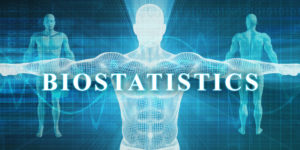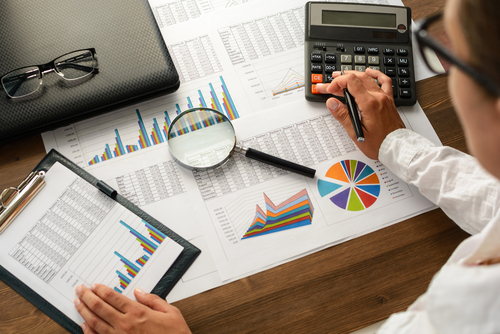
According to the Oxford Journal of Life Sciences, Mathematics and Physical Science, Biostatistics is a field whose primary goal is “to advance statistical science and its application to problems of human health and disease, with the ultimate goal of advancing the public’s health”.
Related resource: Top 5 Most Affordable Online Master’s in Biostatistics
What is Biostatistics?
Biostatistics (or biometry) deals with the statistical processes and methods applied to the analysis of biological phenomena. The science of biostatistics incorporates the design of biological experiments and interpreting the collection, summarization, and analysis of data from those experiments.
What Biostatisticians Do
Biostatisticians have one of the five major roles in public health practice. It’s their job to conduct quantitative research to identify health risks. They’re biomedical researchers who focus on solving community-wide health problems. Biostatisticians follow the scientific method to test their hypotheses with empirical research. Biostatisticians run clinical trials, surveys, lab experiments, focus groups, field observations, and case studies. Compiling and analyzing the data comes next to draw proven conclusions. Biostatisticians use digital software, such as SPSS and SAS, to organize their findings. Biostatisticians then share their statistically significant findings. They might write a journal article, publish a book, give a presentation, or teach a university class. Biostatisticians spread the word to help improve health outcomes. Arming people and public health workers with disease prevention tools is their mission.
Examples of Biostatistical Projects

Biostatisticians undertake various clinical research topics that affect public health. They often focus on a target population, such as elderly adults, infants, or cancer patients. Others take a big-picture look at health concerns like obesity, diabetes, opioid addiction, and smoking. Biostatisticians usually must write research proposals with detailed study designs to apply for grants. Proposed projects on pressing, life-altering health issues are the most funded. For example, a biostatistician might study birth defects caused by selective serotonin reuptake inhibitors. Biostatisticians could test how exercise correlates to hypokinetic diseases. A biostatistician may investigate the harm of environmental air pollution on people’s lungs. Biostatisticians can determine the effectiveness of light therapy for patients with dementia. Virtually any health-related subject is in a biostatistician’s wheelhouse for transformative research.
Where Biostatisticians Do Research
Biostatisticians are commonly employed by local, state, and regional health departments. At the federal level, biostatisticians work for divisions in the Department of Health and Human Services. For instance, biostatisticians can aid epidemiologists in research at the Centers for Disease Control and Prevention. Many are employed by public or private nonprofit and for-profit hospitals. Medical facilities currently posting jobs for biostatisticians include NYU Langone Health, Christiana Care, Fox Chase Cancer Center, the Cleveland Clinic, and the City of Hope. Pharmaceutical companies, such as Pfizer, AstraZeneca, Merck, and Bristol Myers Squibb, hire biostatisticians for clinical trials. Universities employ biostatisticians in their public health departments to conduct research and teach students. Biomedical research and development corporations like Novartis or Leidos also have biostatisticians on the payroll.
Requirements to Become a Biostatistician
Like other mathematicians, biostatisticians need a master’s degree or higher to practice. A biostatistician’s journey starts with four years, or 120 credits, of baccalaureate education after high school. Declaring bachelor’s majors in statistics, math, public health, psychology, and even computer science can help. As an undergrad, take at least one statistics and research methods course. Applying for graduate school comes next. Most graduate programs for biostatisticians require taking the Graduate Record Exam (GRE). Once admitted, future biostatisticians must finish 30+ master’s credits and thesis research. Master of Public Health concentrations also typically entail 240 or more hours of fieldwork. Individuals who already have a master’s degree could add a certificate in biostatistics instead. Employers, especially colleges, may prefer hiring biostatisticians with a Doctor of Philosophy (Ph.D.) or Doctor of Public Health (Dr.PH).
Higher education isn’t the only requirement to become a biostatistician; experience matters too. Organizations look for biostatisticians with a clear understanding of scientific research. Internships, cooperative education, and capstone projects can build this knowledge. The American Statistical Association (ASA) keeps a running tally of available internships to peruse. Many biostatisticians have to work their way up from entry-level jobs. Future biostatisticians may work as data analysts to sharpen their numerical abilities. Individuals can start as research assistants to learn laboratory protocol firsthand. Young quantitative scientists might find principal investigators who will mentor them. Some biostatisticians migrate into the field from other “Big Data” careers. Filling a resume with STEM education and experience is the key to success.
Skills Biostatisticians Must Possess
Intrigued by the work of biostatisticians? Let’s run through a checklist of necessary skills new biostatisticians need then. Biostatistician job descriptions always list mathematical skills to run accurate data analysis. Biostatisticians must be keen problem-solvers with logical reasoning skills. Biostatisticians must have strong decision-making skills to settle on the right research solutions. Biostatisticians are excellent writers who can publish long reports in prestigious academic journals like Biometrics. Biostatisticians need oral speaking skills to communicate with research team members and study participants. Reading comprehension skills help biostatisticians understand the industry’s current research literature. Biostatisticians with basic programming skills, such as SQL and Python, are in demand. Biostatisticians also need time management skills to multi-task on projects and meet research deadlines.
Average Salary Potential for Biostatisticians
Biostatisticians typically work full-time for 40-50 hours per week in an office or laboratory setting. In exchange for cutting-edge biomedical research, biostatisticians are paid a handsome salary. The U.S. Department of Labor reported that the 39,090 statisticians, including biostatisticians, earned a mean annual wage of $95,680 in May 2019. That’s equivalent to an average hourly wage of $46.00. The lowest 10 percent of biostatisticians received a median $52,690 salary. The top 10 percent of biostatisticians made a median income of $146,770. Most biostatisticians fell between the $68,480 and $118,790 mark. Biostatisticians at general and surgical hospitals brought home a mean paycheck of $86,360 annually. Pharmaceutical manufacturing companies paid biostatisticians $107,450 on average. The federal executive branch compensates the best with a $108,700 median rate. The best-paying states for biostatisticians are Massachusetts, New Jersey, Idaho, and California with average earnings over $110,000.
Non-Monetary Benefits of Working in Biostatistics
According to CNN Money, biostatisticians have America’s 48th best job with straight-A ratings for satisfaction, low stress, and benefit to society. Biostatisticians feel rewarded by performing meaningful research that could save countless lives. Biostatisticians enjoy one of the fastest-growing STEM careers in health care. The 10-year job outlook for biostatisticians shows a huge 34 percent increase. Searching for biostatistical openings won’t take long. The unemployment rate in biomedical science is only 2.4 percent. Biostatisticians sometimes enjoy the freedom of telecommuting. Many biostatisticians work from a home office between fieldwork. During clinical research, biostatisticians can travel the globe and interact with diverse people of varying cultures. Unlike most research gigs, biostatisticians don’t need a doctorate. Solving complex statistical challenges is fun for people with a math-oriented mind too.
What are the Degree Options for a Career in Biostatistics?
The journey to becoming a Biostatistician can be intensive and lengthy, however it can also be a rewarding and well-paid career path. Most educational programs in biostatistics are at the postgraduate level and are usually found in schools of public health, affiliated with schools of medicine, forestry, or agriculture, or as a focus area in statistics departments. The Master’s and Doctoral programs in Biostatistics are designed to develop fundamental skills in the statistical sciences with an emphasis on applications in the health sciences by utilizing the basic elements of epidemiology, biology, and computing science, to maintain the character and independent characteristics of statistics. Although Master’s degrees in Biostatistics are readily available, for example, a Master of Science in Biostatistics, it is sometimes available as a specialization area within a graduate degree program in public health, professional science, or computer science.
- Master’s Degree in Biostatistics – A Master’s Degree Program in Biostatistics usually consists of between 30-48 credit hours and can take two to three years for completion. The length of time for degree completion can be shorter or longer, depending on the individual program, previous college credit, and whether it is a full time or part-time program. A Master’s Degree in Biostatistics focuses on applying both descriptive and inferential statistics as it applies to biomedical research and clinical, public health, and industrial issues related to human populations. Coursework can include Principles of Biostatistics, Statistical Computing, and Epidemiology. Completion of a Master’s Degree may require students to complete a data analysis project with their results are presented
- Doctoral Degree in Biostatistics – The doctoral degree program prepares individuals for research and teaching positions within academic institutions, and for executive leadership positions in health-based organizations and industry. Most Biostatistics doctoral candidates have completed a Master’s Degree in Biostatistics or an equivalent advanced degree and possess strong backgrounds in mathematics, biostatistics, statistics, or other quantitative fields. A Ph.D. program in Biostatistics is designed for those individuals who wish to pursue careers in biological, medical, or health sciences. The curriculum can be tailored to match background and interests.
What Does Someone Do With A Degree in Biostatistics?
Biostatisticians are employed in health organizations, government agencies, universities, and even private companies. They are responsible for monitoring the spread of disease and the causes of death to protect the population. Biostatistics is a billion-dollar industry and it is an important part of improving human health and increasing knowledge of public health issues. The government and the pharmaceutical industry are the main contributors to the Biostatistics industry. The Bureau of Labor Statistics predicts that the job outlook for all types of statisticians, including biostatisticians, will experience a growth rate of 30% between 2018 and 2028.
The field of Biostatistics is a highly respected, well-paid field of practice. Individuals with the right skill set can pursue an exciting and important career. For individuals with a strong interest in mathematics, science, statistics, and health, a position as a Biostatistician is an excellent way to combine your strengths.